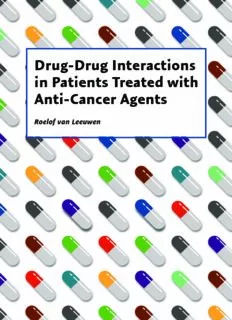
Drug-Drug Interactions in Patients Treated with Anti-Cancer Agents PDF
Preview Drug-Drug Interactions in Patients Treated with Anti-Cancer Agents
Drug-Drug Interactions in Patients Treated with Anti-Cancer Agents Roelof van Leeuwen Drug-Drug Interactions in Patients Treated with Anti-Cancer Agents Geneesmiddel interacties bij patiënten die behandeld worden met antikanker geneesmiddelen Roelof van Leeuwen PROMOTIECOMMISSIE Promotoren: Prof.dr. T. van Gelder Prof.dr. A.H.J. Mathijssen Overige leden: Prof. dr. P. Sonneveld Prof. dr. A.J. Gelderblom Prof. dr. J.H. Beijnen Copromotor: Dr. F.G.A. Jansman Colophon ISBN: 978-90-825123-1-1 Cover design: proefschrift-aio.nl Layout: proefschrift-aio.nl © R. van Leeuwen, 2016 Mede mogelijk is gemaakt door Stichting de Merel, Stichting Coolsingel, Pfizer B.V., Boehringer Ingelheim, Bayer B.V., Astra Zenica, Sanofi Aventis en Astellas Pharma B.V. Drug-Drug Interactions in Patients Treated with Anti-Cancer Agents Geneesmiddel interacties bij patiënten die behandeld worden met antikanker geneesmiddelen Proefschrift ter verkrijging van de graad van doctor aan de Erasmus Universiteit Rotterdam op gezag van de rector magnificus prof.dr. H.A.P. Pols en volgens besluit van het College voor Promoties. De openbare verdediging zal plaatsvinden op vrijdag 22 april 2016 om 11.30 uur door Roelof Wouter Frederik van Leeuwen geboren te Maarssen CONTENTS Chapter 1 Introduction 6 Chapter 2 Drug-drug interactions with tyrosine kinase inhibitors: a clinical perspective Lancet Oncol. 2014 Jul;15(8):e315-26 20 Chapter 3 Potential drug interactions in cancer therapy: a prevalence study using an advanced screening method Ann Oncol. 2011 Oct;22(10):2334-41 54 Chapter 4 Potential drug-drug interactions in cancer patients treated with oral anti-cancer drugs Br J Cancer. 2013 Mar 19;108(5):1071-8 76 Chapter 5 Drug-drug interactions in patients treated for cancer: a prospective study on clinical interventions Ann Oncol. 2015 May;26(5):992-7 100 Chapter 6 Influence of the acidic beverage cola on the absorption of erlotinib in patients with non–small-cell lung cancer J Clin Oncol. 2016; Feb 8. Epub ahead of print 122 Chapter 7 Tyrosine kinase inhibitors and proton pump inhibitors: really incompatible? Submitted 140 Chapter 8 Summary 152 Appendices S amenvatting 160 Dankwoord 170 Curriculum Vitae 178 Publications 182 PhD portfolio 188 6 Chapter 1 1 GENERAL INTRODUCTION AND AIMS OF THIS THESIS General Introduction 7 CANCER 1 Cancer is a significant and leading public health burden and a major cause of morbidity and mortality among men and women worldwide. Especially due to growth, aging and adaptation of deleterious behavior and lifestyle of the worldwide population, this burden is expected to grow in the coming years.1 Although treatment options such as cytotoxic chemotherapy, (anti)hormone therapy and the more recent targeted agents are rapidly evolving, anticancer treatment is still associated with many challenges. Since most anticancer drugs have narrow therapeutic windows it is important to “get the dose right” in order to optimize drug exposure and effect and minimalize side effects.2 To accomplish this goal there is a shifting paradigm towards individualized dosing rather than flat-fixed dosing in order to optimize cancer therapy. Along with other factors, such as life style, genetic factors and organ (dys)function, the use of comedication and the subsequent risk for drug-drug-interactions (DDIs) is one of the key factors influencing systemic drug exposure in cancer patients (figure 1).2 Other factors Patient Illness related characteristics (i.e. performance status) (i.e. age, sex) Body size-measurements Exposure Genetic factors (i.e. BSA,BMI) Lifestyle Co-medication (i.e. smoking, use, (including OTC-drugs) food effects) Organ function (i.e. kidney- and liver function) Figure 1: Key factors influencing the systemic exposure to an anticancer drugs Abbreviations: BMI: body-mass index; BSA: body-surface area; CAM: complementary and alternative medicine; PPI: proton-pump inhibitor; SNPs: single-nucleotide poly- morphisms. General Introduction 9
Description: